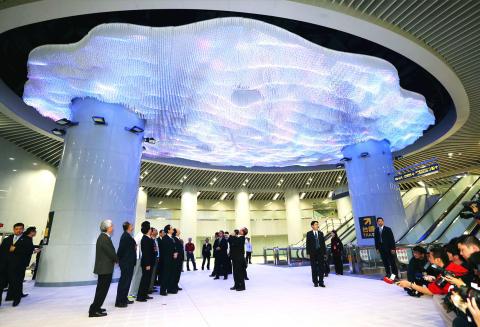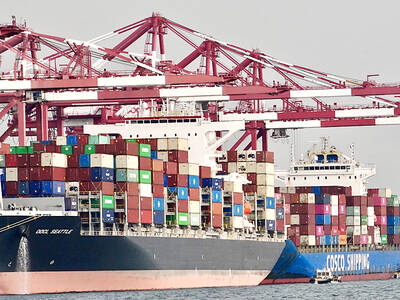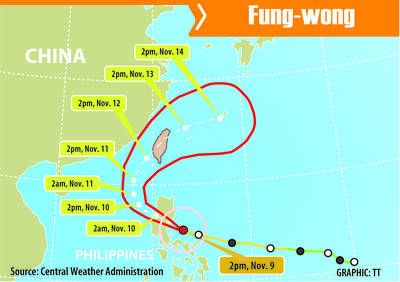The Taipei MRT’s newly completed Songshan Line is an important addition to the capital’s transportation network, as it provides more transfer options, Taipei Mayor Hau Lung-bin (郝龍斌) said at the line’s inauguration ceremony yesterday.
Under construction since 2006, the line was originally scheduled to open last year, but was held up by the discovery of a Qing Dynasty-period archeological site near the line’s Beimen Station, Taipei’s Department of Rapid Transit Systems said.
President Ma Ying-jeou (馬英九), Hau and other dignitaries yesterday toured displays of the discovered artifacts within Beimen Station, before stepping into an MRT train for a ride to the line’s Songshan terminal station.

Photo: CNA
“To maximize the ease of transferring between lines, Taipei’s MRT system was designed around three horizontal and vertical lines, with Songshan the final horizontal line,” Hau said, adding that with the opening, the city’s core MRT network is now completed.
With the exception of the airport MRT line being constructed by the Taiwan High Speed Rail Corp (台灣高鐵) to connect Taipei Main Station to Taiwan Taoyuan International Airport, all new lines called for in city plans would boast only a “medium level” passenger capacity, a step below the “high level” capacity of most of Taipei’s current lines, the department said.
Meanwhile, Hau clarified earlier remarks suggesting that Taipei independent mayoral candidate Ko Wen-je (柯文哲) winning the Nov. 29 election would lead to chaos in plans for the development of Greater Taipei’s public transportation system.

Photo: CNA
Hau, a member of the Chinese Nationalist Party (KMT), said that a non-KMT mayor might have trouble communicating effectively with the mayors of New Taipei City and Keelung, calling on all candidates to state clearly their position on planned future MRT lines linking the three cities.
The Songshan Line is an extension of the Xindian Line, running through eight stations, most of them parallel to Nanjing E Road: Ximen, Beimen, Zhongshan, Songjiang Nanjing, Nanjing Fuxing, Taipei Arena, Nanjing Sanmin and Songshan.
With the opening of the extension, trains will no longer run directly between the Xindian and Tamsui stations.
Four stations along the line connect with other MRT lines: Ximen to the Bannan Line, Zhongshan Station to the Tamsui-Xinyi Line, Songjiang Nanjing Station to the Zhonghe-Xinlu Line, the newly renamed Nanjing Fuxing Station (formerly Nanjing East Road Station) to the Wenhu Line, as well as Songshan Station to the Taiwan Railways Administration’s Songshan Station.
The Songshan Line is to start service at 6am today, allowing free travel for EasyCard holders for one month, the Taipei City government said.
Additional reporting by CNA

The Central Weather Administration (CWA) yesterday said it expected to issue a sea warning for Typhoon Fung-Wong tomorrow, which it said would possibly make landfall near central Taiwan. As of 2am yesterday, Fung-Wong was about 1,760km southeast of Oluanpi (鵝鑾鼻), Taiwan’s southernmost point, moving west-northwest at 26kph. It is forecast to reach Luzon in the northern Philippines by tomorrow, the CWA said. After entering the South China Sea, Typhoon Fung-Wong is likely to turn northward toward Taiwan, CWA forecaster Chang Chun-yao (張峻堯) said, adding that it would likely make landfall near central Taiwan. The CWA expects to issue a land

Taiwan’s exports soared to an all-time high of US$61.8 billion last month, surging 49.7 percent from a year earlier, as the global frenzy for artificial intelligence (AI) applications and new consumer electronics powered shipments of high-tech goods, the Ministry of Finance said yesterday. It was the first time exports had exceeded the US$60 billion mark, fueled by the global boom in AI development that has significantly boosted Taiwanese companies across the international supply chain, Department of Statistics Director-General Beatrice Tsai (蔡美娜) told a media briefing. “There is a consensus among major AI players that the upcycle is still in its early stage,”

The Central Weather Administration (CWA) yesterday said it is expected to issue a sea warning for Typhoon Fung-wong this afternoon and a land warning tomorrow. As of 1pm, the storm was about 1,070km southeast of Oluanpi (鵝鑾鼻), Taiwan’s southernmost point, and was moving west-northwest at 28 to 32kph, according to CWA data. The storm had a radius of 250km, with maximum sustained winds of 173kph and gusts reaching 209kph, the CWA added. The storm is forecast to pass near Luzon in the Philippines before entering the South China Sea and potentially turning northward toward Taiwan, the CWA said. CWA forecaster Chang Chun-yao (張峻堯) said

Japanese Prime Minister Sanae Takaichi yesterday said that China using armed force against Taiwan could constitute a "survival-threatening situation" for Japan, allowing the country to mobilize the Japanese armed forces under its security laws. Takaichi made the remarks during a parliamentary session while responding to a question about whether a "Taiwan contingency" involving a Chinese naval blockade would qualify as a "survival-threatening situation" for Japan, according to a report by Japan’s Asahi Shimbun. "If warships are used and other armed actions are involved, I believe this could constitute a survival-threatening situation," Takaichi was quoted as saying in the report. Under Japan’s security legislation,